Chester
The historic city of Chester was founded by the Romans who established a fort there, known as Deva, in about 60 AD as a strategic site for a garrison of occupying troops.
The River Dee at Chester

The medieval Old Dee Bridge dates from around 1387 and was constructed on a site previously occupied by numerous wooden bridges. The bridge once had strong towers, a drawbridge and portcullis. The bridge was damaged at the time of The Civil War during the siege of Chester, to prevent the Parliamentary forces from using the city as a base. The Grosvenor Bridge is a single-span arch road bridge over the River Dee which is constructed from sandstone. The graceful structure was designed by Thomas Harrison, and was opened in 1832.
The Chester Visitor Centre on Vicars Lane is a good starting point from which to explore the city, it contains the Roman Amphitheatre exhibition, DVD shows, the Rows cafe and a gift shop.
The city retains many interesting sites from the period including the Roman Amphitheatre, which dates from around 86A.D. Semi circular in shape, as only half of it has been excavated, the Ampitheatre is the largest yet excavated in the whole of the British Isles, the remains were discovered in June 1929 by an amateur archaeologist.
The Roman Amphitheatre
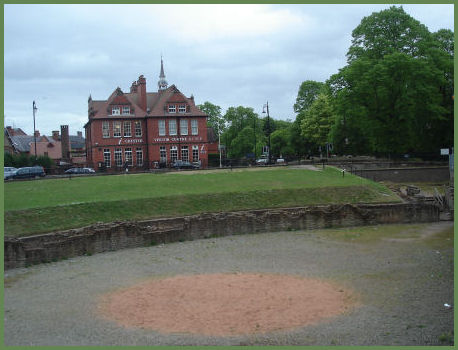
The Chester City Walls are the only complete city walls in Britain, they form a two mile (3 km) circuit around the historic city centre, and form a pleasant walk from which many of the city's key heritage sites can be seen.The red sandstone walls contain Roman and Saxon fragments.
The walls have their origin in Roman times, when Chester was known as Dewa, although they were succesively altered in the Saxon and medieval periods. The Normans extended the original circuit, adding towers, gates and a ditch. Along the northern sections of the wall, the Roman foundations are still visible. During the civil war, the Roundheads attacked King Charles I and his Royalist supporters in the city, in the course of which, the city walls were badly damaged. Repairs to damage caused at this period can still be clearly seen in the section of the walls which adjoins the Roman Gardens. During the seventeenth century, when the walls became largely redundant in terms of defence, they were turned into a fashionable two mile circular promenade.
The Roman Gardens stand to the south east of the city, just outside the city walls. The gardens were constructed in the 1949 to display the building fragments from the Roman legionary fortress of Deva and artifacts found throughout the city. The project formed part of Chester's contribution to the 1951 Festival of Britain. They contain an interesting reconstruction of a hypocaust, a Roman underfloor heating system, the imposing columns on the site were taken from the exercise hall of the Roman bathhouse.
The Roman Gardens from the City Walls

The Dewa Roman Experience allows the visitor to relive the sights, sounds and smells of daily Roman life and is well worth a visit, while the Grosvenor Museum has an impressive collection of Roman tombstones a the Webster Gallery. The gallery takes the visitor on a walk through a Roman cemetery. Four altars to Roman gods include one to Nemesis, the goddess of fate or destiny. The museum has many fascinating displays that build a vivid picture of Roman Chester.
The Rows are a unique series of two tiered and mostly half timbered shopping arcades, which are a curious mix of Medieval and Victorian architecture. The Three Old Arches in Bridge Street is purported to be the oldest surviving shop frontage in Britain. Parts of the building date back as far as 1274. The arches at Row level are some of the earliest structures in the Rows. Bishop Lloyd's Palace, otherwise known as Bishop Lloyd's House is located at 41 Watergate Street, and 51/53 Watergate Row. The architectural historian Nikolaus Pevsner considered it to be "perhaps the best" house in Chester and It has been designated by English Heritage as a Grade I listed building. The Abbey Gateway leads from Northgate Street into Abbey Square. The gateway dates back to around 1300 and was built as a gatehouse, its upper storey was rebuilt in around 1800. It was once the main access to the precinct of St Werburgh's Abbey. During the Middle Ages it was the first station for performances of the Chester Mystery Plays.
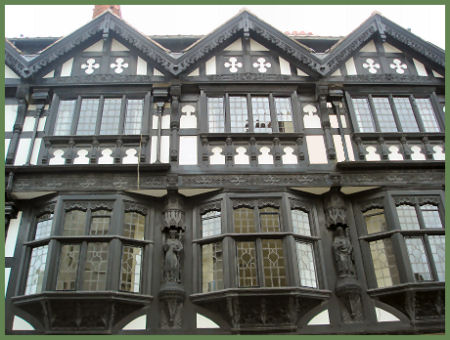
The half timbered Falcon Inn in Lower Bridge Street dates back to 1200 and originated as a private house and still retains its external staircase. The medieval undercroft is now used as a beer cellar. The Bear and Billet inn has been designated by English Heritage as a Grade I listed building and has been described as "the finest 17th-century timber-framed town house in Chester". It stands on the west side of Lower Bridge Street, to the north of Bridgegate. The building dates to 1664 and was once the town house of the Earls of Shrewsbury. It became an inn in the 18th century. The timber framed Blue Bell Inn in Northgate Street, Chester, Cheshire, England. was once two medieval houses which were joined together in the 18th century. The building dates from the mid to late 15th century and is said to be the oldest surviving intact medieval house in Chester.
Chester Cathedral, a beautiful red sandstone building, was founded in Saxon times, and is dedicated to St. Wedbergh, a Saxon Princess and grand-daughter of Penda of Mercia. The original church on the site was replaced by a Benedictine abbey, founded in 1092 by the Norman Hugh Lupus, Earl of Chester, perhaps in form of expiation for his worldly excesses. Hugh recieved the help of the saintly Anselm in his project. The cathedral was consecrated in 1541, following the Dissolution of the Monasteries in the reign of Henry VIII.
Chester Cathedral
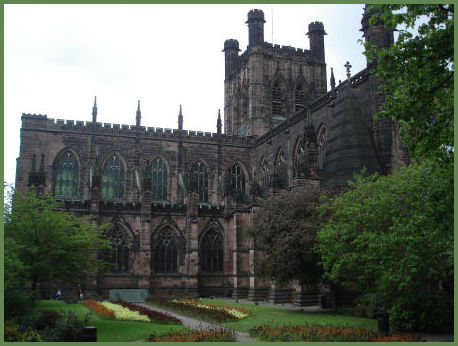
Chester's Grosvenor Park, which lies adjacent to the River Dee, is regarded as one of the finest and most complete examples of Victorian Parks in the north west of England. The sixteen acres which form the park were donated to the City by Richard, the second Marquis of Westminster. A statue of the marquis, created by Thomas Thornycroft, stands in the park. Grosvenor Park Lodge is a black and white half timbered building adorned with statues which represent William the Conqueror and the Norman Earls of Chester.
Georgian houses by the cathedral
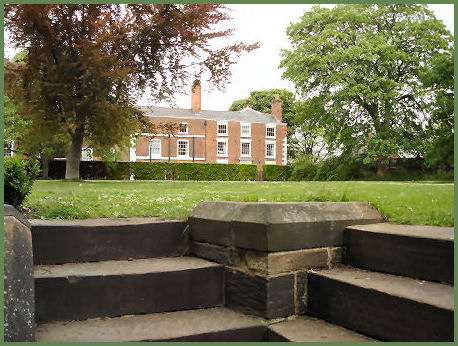
In nearby St. John's Street stands the twelfth century Church of St. John the Baptist which boasts some imposing Norman architecture The remains of the Norman choir and medieval chapels which once formed the east end of St. John's church.
The Eastgate Clock, one of Chester's most famous landmarks and the second most photographed timepiece in Britain, surmounts the Eastgate archway. The archway was built in 1899 to commemorate Queen Victoria's diamond jubilee and was designed by architect John Douglas. Douglas played a major part in the city's Victorian half timbered architectural revival.
Eastgate
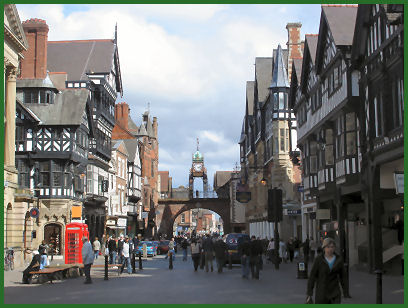
Chester Zoo is the largest Zoo in the United Kingdom and covers an area of over 100 acres within a total land holding of over 400 acres and contains 500 different species of animals and award winning gardens. The Zoo was founded in the early 1930's by George Mottershead and is now operated by the North of England Zoological Society.
Regular open top fully guided sightseeing bus tours of the city are available from which to appreciate the 2,000 years of Chester's history. Tickets can be purchased from the Chester Visitor Centre, the Tourist Information Centre or from the bus driver.
There are also a number of cruises on the River Dee help the visitor to see the best of Chester and its sights. Half hour cruises operate every thirty minutes. There are also rowing boats for hire on the river.
